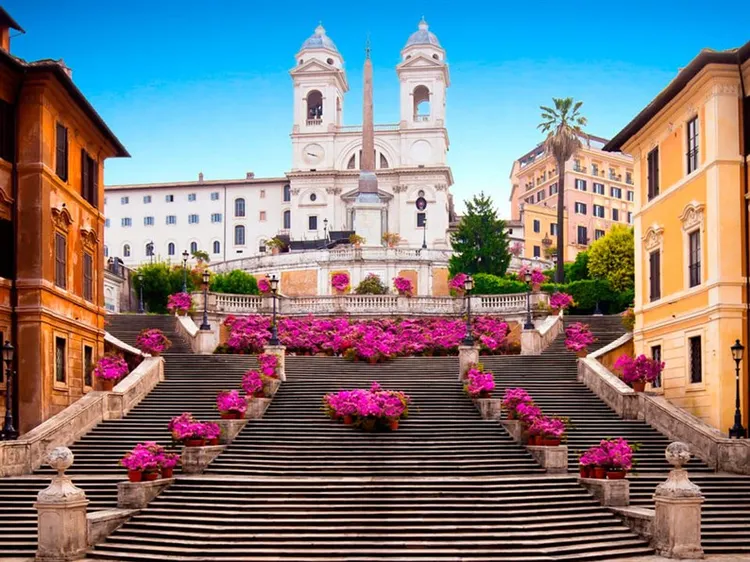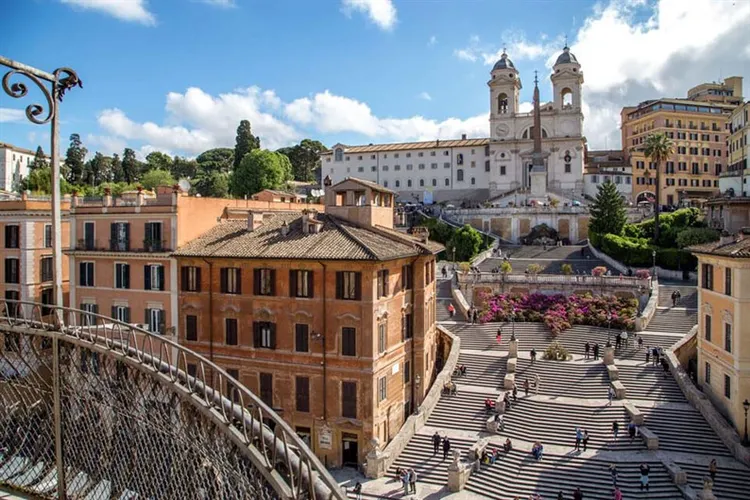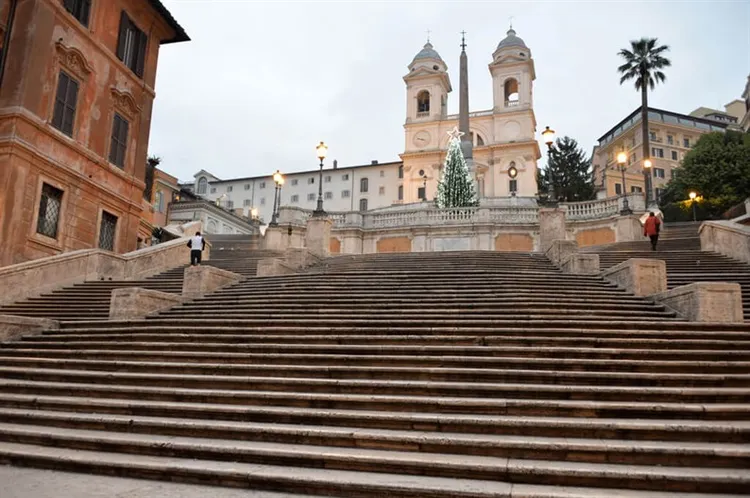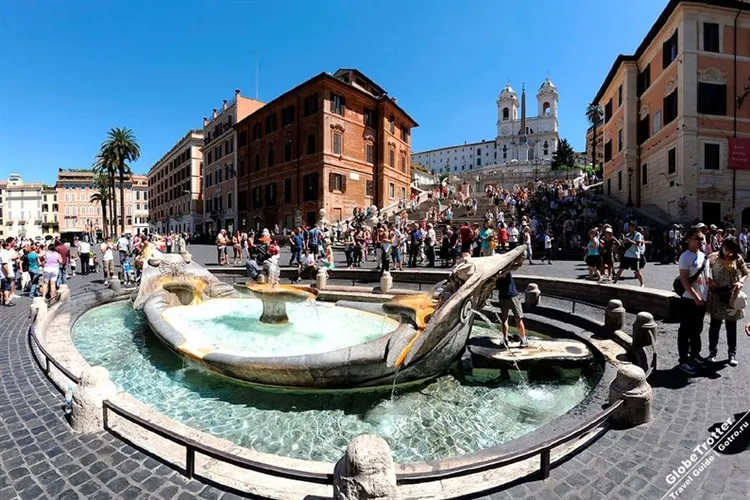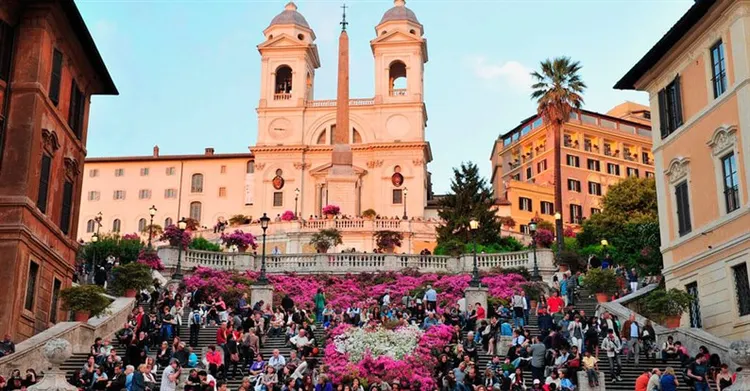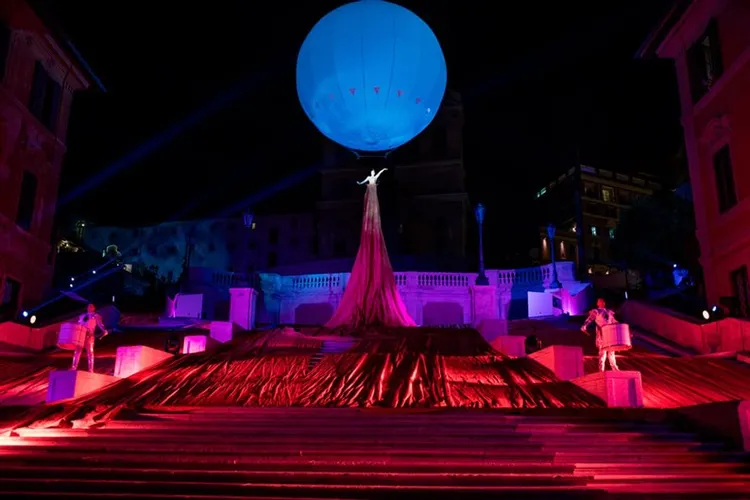Spanish Steps in Rome – history, photo, description, how to get there, map
The capital of Italy discourages and impresses with its beauty. The streets of Rome are full of bizarre architecture of buildings that reflect the glorious history of the city. For a millennium, Rome experienced ups and downs. Despite the destruction of the Roman Empire, after its power and prosperity, the city continued to maintain its unique beauty and originality. The modern look of ancient Rome is framed in the wise grandeur of the past.
Why is the staircase called Spanish
After the collapse of the Roman Empire, fragmented kingdoms formed on the modern territory of the ancient state, which were constantly attacked by strong neighboring powers. Rome turned out to be the stronghold of the Christian world, which was formed in the form of a sovereign country – the Papal State. The state was ruled by an episcopate headed by the Pope of Rome. For centuries, the powerful French and Spanish communities exerted their pressure on the political course of the Papal States.
In 1502, on the initiative of King Louis XIII of France, the shrine of Trinita dei Monti was erected on the top of the Roman hill of Pincho. The church was supposed to prove the favorable disposition of the Romans towards the French king. However, at the beginning of the 17th century, at the foot of the slope, just opposite the church, the embassy of the Spanish kingdom settled. The luxurious residence clearly dominated the French temple.
It turned out such a situation that the symbols of the warring rival countries were not far from each other. The square, where the two sights are located, became known as the Spanish. In order to avoid a political quarrel between the Papal States and two influential powers, it was decided to connect the church and the embassy territorially with a single luxurious staircase. Subsequently, it was she who received the popular name after the name of the square. By the will of fate, its construction will be carried out much later.
Construction history
The staircase in the Roman square has a rather complicated construction history. In the middle of the 17th century, a series of fierce wars began between Spain and France. This chain of conflicts between countries has made its own adjustments to the gentrification of the neighborhood around the square. The war, which lasted more than 20 years, delayed the construction of the stairs.
When the confrontation between the two royal powers subsided, the French ambassador in Rome, Etienne Gouffier, allocated substantial funds for the construction of a monumental staircase. The main concept of the construction was to improve diplomatic relations, as well as to conclude an indestructible alliance between France and Spain. The implementation of this plan was prevented by the ambition of one of the parties.
Cardinal Mazarin, who is the first minister of the French kingdom, wished that the staircase was crowned with a sculptural composition headed by the image of Louis XIV on horseback. The Pope and the Spanish side opposed this idea. Construction again had to be suspended. In 1723, the construction of the stairs resumed. At this time, the political situation in France changed. The young Roman architect Francesco de Sanctis, who won the competition among the architects of the city, dared to implement the project. The land of the steep slope on which the staircase was supposed to rise was regularly washed away by torrential torrents.
There was a danger that the ground would not withstand the heavy structures of the stepped ramp. It took two whole years to carry out measures to strengthen the soil. According to the project, the staircase acquired a wide three-tier passage, framed by two side narrow spans. It leads to the observation deck, which was placed in the center on the top of the hill, and decorated with a balustrade around. The elegant staircase included 138 steps with a concave, non-uniform, but symmetrical shape. For their manufacture, a stone was used that combines the properties of limestone and marble – travertine.
Large deposits of this material were located on the outskirts of Rome. In some places the stairs were narrow, while in others they were wider. The difference in the size of the overhead treads is explained by the fact that the architect wanted to give an unusual attractive appearance to the structure. The side part of the building was shaped with stone parapets, decorated with the symbols of the Pope and the heraldic sign of the kings of France. The final completion of the construction took place in 1725.
Barcaccia Fountain
At the foot of the Spanish Steps is the small Barcaccia Fountain. The pool was installed in 1629. The construction expresses in its appearance a half-submerged boat, from the cracks of which water flows. The boat is in the center of the pool. The author of this project is Pietro Bernini. In the Middle Ages, Rome was flooded several times. The waters of the Tiber River, emerging from unfortified banks, spilled over the entire historical center of the city. This natural cataclysm was captured in the image of a fountain.
According to legend, after a natural disaster, a wooden ship was thrown into the Plaza de España, carrying barrels of wine. The sight of a half-sunken boat inspired the sculptor to create a white marble water complex in this place. The architect decorated his creation with the heraldic symbol of Pope Urban III of that time – a relief image of the sun and bees. The sculptural work fits perfectly into the overall architectural ensemble of the square. The fountain is supplied with water from a clean drinking source, so many residents and guests of Rome do not hesitate to fill their glasses, flasks and quench their thirst with it.
Spanish steps today
In the 20th century, the staircase gained its worldwide popularity after the release of the Oscar-winning film “Roman Holiday” with Audrey Hepburn in the title role. In the film, the actress enjoyed ice cream while sitting on the steps of the stairs. Today, many tourists want to repeat the adventures of the film star. In 1992, a fashion show of world famous brands took place on the Spanish Steps. Graceful steps served as an impromptu catwalk for defiling models.
Travertine steps gave the monumental structure strength and durability. Therefore, for more than 250 years, the staircase has not undergone serious restoration. However, at the end of the 20th century, it began to lose its original appearance. The exquisite beauty of the monumental structure was eaten away by the destructive effect of time and precipitation. Numerous crowds of tourists also left their mark. The steps of the stairs darkened, loosened and cracked. The spoiled appearance of the ancient landmark of Rome forced the municipality to temporarily close the building from visitors.
In 2015, largely thanks to private sponsors, repair and restoration work began on the dilapidated staircase. The restoration cost 1.5 million euros. A year later, the grand opening of the renovated attraction took place. The mayor of Rome, Virginia Raggi, has vowed to constantly pay special attention to the old staircase. The head of the city administration instructed the police to strictly monitor the behavior of people and stop their illegal actions.
Today's staircase is a favorite resting place for both residents and visitors to Rome. In good weather, street performers and circus performers always arrange performances here. In summer and spring, the northern part of the building is decorated with beautifully flowering azaleas. In winter, numerous festive Christmas events are held. Everything is full of bright lights and filled with fun vacationers.
Where is it located and how to get there
The Spanish Steps, like a magnet, attracts crowds of tourists. It is located in the Plaza de España in the northern part of Rome. You can get to it by metro, reaching the Spagna station or just walk. There are many bus routes in this part of the city.
